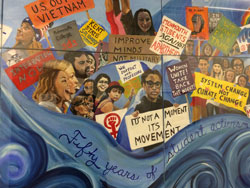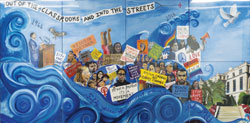On permanent display in Bey Hall is the “Out of the Classroom and Into the Streets” mural, painted by Dr. Johanna Foster, Director of the Sociology Program. The mural celebrates the 50th anniversary of Dr. Martin Luther King, Jr.’s historic visit to Monmouth University and documents the waves of student activism from 1966 to the Black Lives Matter campus rallies in 2016.
The mural, which hangs in the second floor of Bey Hall, is composed of eight 24’’ x 24’’ attached canvases. It depicts the likenesses of 25 student activists on campus, and displays a visual timeline of student demonstrations throughout the years. The building houses the Department of Political Science and Sociology, both of which tie strongly to the subject matter of the piece, which was funded entirely by a generous award from the Monmouth University Research and Creativity Grants Committee.
Although Foster was the primary painter, over 30 students from across academic disciplines participated in the creation of the piece. Ten students contributed as social history researchers and painting assistants as well.
“I was inspired to paint this, as someone who teaches about social inequality and a commitment to racial justice I wanted to find a way to honor King’s visit. I wanted to find a way to connect the gift of his visit and the spirit of his message to the school today,” said Foster.
King spoke in a crowded Boylan Gymnasium on Oct. 6 1966, by invitation from the school’s Black Student Union. According to Foster, this historic event marked an influential point in the University’s history, as well as in the lives of students to come.
University President, Paul Richard Brown Ph.D, said, “The mural is a powerful reminder of the strong commitment to social justice embraced across our campus, by students and faculty alike. We are a caring community, and I think Dr. Foster’s artwork captures that spirit of active participation in issues that affect us all,” Brown added.
Dr. Melissa Ziobro, a specialist professor of public history, said, “I understand that at the time, Dr. King noted that, while we as a country had come a long way, there was still work to be done. You could say those same words today, and it would still be true.”
Michelle Toscano, a junior fine arts student said, “I originally worked on the mural as a project for a final for my gender studies class, but throughout the process I found it much more rewarding. Being able to be a small part of a larger project made me feel important and know that I’ve made my mark on this school the same way individuals in the painting have throughout the years at Monmouth.”
Foster’s interest in using mural art as a voice for communities as well as a teaching tool for marginalized people, translates an empowering message to the University community. Foster urges students to take action, to be active citizens of democracy, and to take their voices seriously.
 “My initial reaction was ‘this is cool,’” said Nina Anderson, the Director of the Office of Equity and Diversity. “I truly appreciate the broad range of issues and persona captured in the mural. I am encouraged by the demonstration of student and community commitment to achieving justice through activism here at Monmouth. It really speaks to the fact that lasting culture change on University campuses is driven by students and that students have voices that can often ring the loudest. The mural also reminds us that there is still work to be done.”
“My initial reaction was ‘this is cool,’” said Nina Anderson, the Director of the Office of Equity and Diversity. “I truly appreciate the broad range of issues and persona captured in the mural. I am encouraged by the demonstration of student and community commitment to achieving justice through activism here at Monmouth. It really speaks to the fact that lasting culture change on University campuses is driven by students and that students have voices that can often ring the loudest. The mural also reminds us that there is still work to be done.”
Phoebe Nelson, a sophomore political science student, said, “I think it is really important that people see that the young people painted on that mural are just like us, and that they decided to voice something they cared about and wanted to make change. That is really inspiring.”
Dr. Ken Mitchell, Chair of the Political Science and Sociology Department, said, “This mural has the potential to remind young people to be actively thinking about the future and about society. We need political activism today just as much as we’ve needed it in the past. It is a natural impulse to have current issues be more important, which is why there is always a place for student activism, especially at Monmouth University.”
The Sociology Program will host an informal ‘opening’ of the project on Wednesday, Mar. 1, from 4:30 to 6:00 p.m. in Bey Hall Room 226. At that time, Foster will present some background on the activism featured in the mural and give thanks to the current student activists who helped make the work possible.
PHOTO TAKEN by Jamilah McMillan



